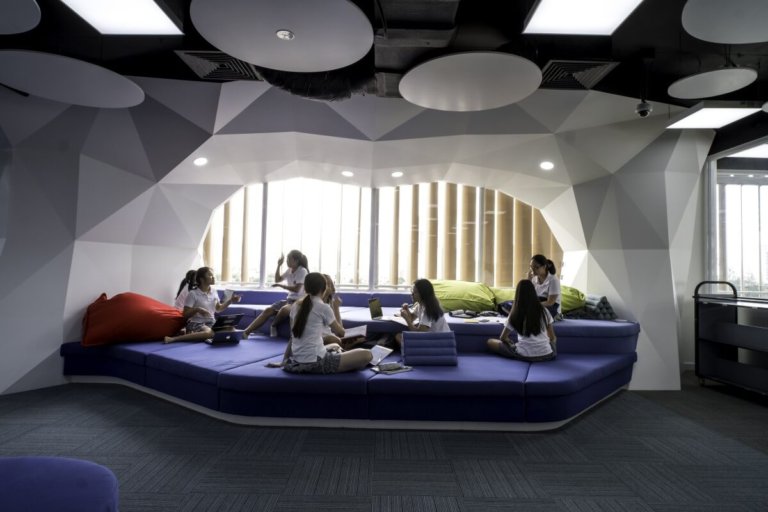
How do learning spaces impact student performance? The subtle nuances of classroom design – be it the practical use of indoor and outdoor spaces to light sources – can have a powerful effect on students’ learning and well-being. This means that parents who are looking for the ideal school for their child will need to consider design as part of the perfect school ‘package’.
International School Ho Chi Minh City (ISHCMC) understands the connection between physical learning spaces and student well-being, injecting design elements in both its primary and secondary schools to optimise the student learning experience. ISHCMC, the most experienced international school in Ho Chi Minh City, Vietnam, has over 55 nationalities represented on campus. It boasts a strong reputation both in Asia and the world, known for adopting a progressive mindset and disrupting the norms of education.
The school has developed a stellar reputation in Asia for disrupting the norms of education, with the learning environment forming part of it.
Re-envisioning learning spaces
ISHCMC, which provides three International Baccalaureate Programmes (Primary Years Programme, Middle Years Programme and the IB Diploma), has recently undergone a facelift. But the physical changes go beyond the mere aesthetics; according to ISHCMC Head of School, Adrian Watts, the renovations aim to improve learning outcomes and ensure students are equipped with skills for the future.

Source: ISHCMC
Instead of harsh fluorescent lights, the new secondary campus and refurbished primary school campus uses plenty of natural light. The glass walls don’t just give the school a more modern and attractive look, but make classrooms look less confined. Hallways are spacious while learning takes place both in and outside of the classroom. Meanwhile, the air filtration system is a key feature in both the refurbished primary and secondary campus, ensuring students enjoy clean air during school hours.
Students here are not typically pinned to their desks. For instance, Watts explained that primary school students are empowered to decide which setting best suits their learning style – seen through their flexible classroom seating arrangements – which results in students being more engaged in their learning.
With climate change standing as the defining issue of our time, sustainability is at the forefront of the minds of many. Sustainable activities, such as gardening, are known to have a positive impact on well-being across all ages. As such, students tend to the plants and vegetables growing in the garden, which teaches them where food comes from and how they can grow it. Students are exposed to different gardening methods, such as aquaponics and hydroponics, while the school also has recycling grinders and partnerships with NGOs to further its sustainability mission.
An environment that promotes students’ academic prowess
Learning takes a dynamic form when students have the opportunity to practice what they’ve been taught.

Source: ISHCMC
“We work very hard towards ensuring the way teachers teach encourages conceptual understanding,” shared Watts. As an antidote to rote learning, the school encourages students to ask questions and have reflection sessions on their previous day’s goals, their goals for the day and how they plan to achieve them, as well as what they’ve been taught after class. This helps students embed knowledge in their memory whilst learning skills they can utilise throughout their school and future work life.
Mindfulness in education
Today’s students are growing up in an age that’s “never quiet”. Social media constantly bombards them with notifications of what their peers are up to, while their phones are platforms for them to browse online at any time. To ensure students maintain their well-being, daily mindfulness lessons are held to encourage positive emotions among students and teachers, in addition to helping them re-centre and prepare themselves emotionally for the day ahead.
Watts explained that the school often invites guest speakers and offers seminars and workshops that relate to preserving their well-being. For instance, they’ve had doctors give presentations on the importance of sleep, enabling students to understand its importance and thus, learn to take control of their lives.
As many of today’s adolescents suffer from anxiety and depression, Watts explained that mindfulness and meditation can help students take control of that. “Just a few deep breaths can bring you back into a position of well-being,” he said.

Source: ISHCMC
Ensuring students are technologically-savvy
Technology is advancing at an accelerated speed, while automation promises to usher in a new era of work, replacing many professions as we know them today. For instance, the role of social media manager is already at risk of becoming defunct thanks to algorithms. As today’s youth need to learn to work with and alongside technology to thrive in the future workforce, the school integrates technology into the student learning experience.
ISHCMC is home to cutting-edge technology, including 3D printers, as well as media technology such as studios, green screens and film rooms, to complement traditional learning. These platforms also allow students to demonstrate what they’ve learnt, and practice using technology in “the wisest” way, Watts explained.
ISHCMC prides itself on providing students with a clean and sustainable environment that allows them to reach their full potential, becoming independent and self-reliant individuals who are ready to tackle the next set of challenges in university and beyond. But more than offering students charming spaces to learn, study and mingle, ISHCMC encourages a balance between academic achievement and whole child development.
Follow ISHCMC on Facebook, Twitter, YouTube and BlogSpot
Liked this? Then you’ll love these…
ISHCMC: Celebrating 25 years of innovative education
4 international schools that nurture innovative thinking in students







